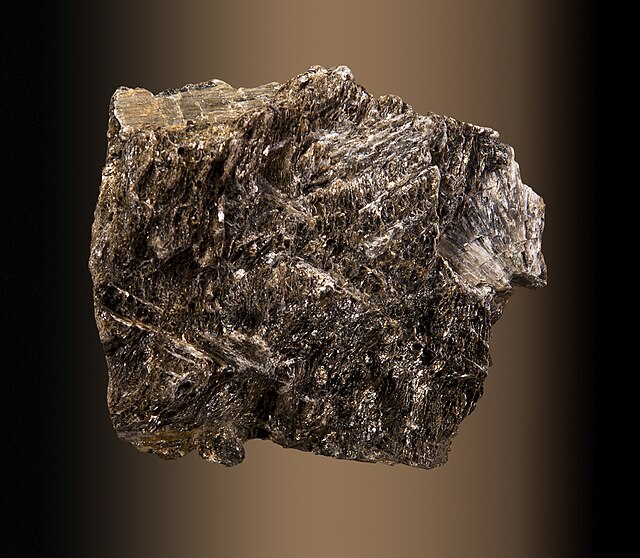Anthophyllite is an orthorhombic amphibole mineral: ☐Mg2Mg5Si8O22(OH)2 (☐ is for a vacancy, a point defect in the crystal structure), magnesium iron inosilicate hydroxide. Anthophyllite is polymorphic with cummingtonite. Some forms of anthophyllite are lamellar or fibrous and are classed as asbestos. The name is derived from the Latin word anthophyllum, meaning clove, an allusion to the most common color of the mineral. The Anthophyllite crystal is characterized by its perfect cleavage along directions 126 degrees and 54 degrees.
Anthophyllite
Anthophyllite in serpentinised komatiite, Maggie Hays Ni Mine, Western Australia
Anthophyllite fibers (SEM micrograph)
Amphibole is a group of inosilicate minerals, forming prism or needlelike crystals, composed of double chain SiO4 tetrahedra, linked at the vertices and generally containing ions of iron and/or magnesium in their structures. Its IMA symbol is Amp. Amphiboles can be green, black, colorless, white, yellow, blue, or brown. The International Mineralogical Association currently classifies amphiboles as a mineral supergroup, within which are two groups and several subgroups.
Amphibole (tremolite)
Photomicrographs of a thin section containing an amphibole crystal; under cross-polarized light on the left, and plane-polarized light on the right.
Double-chain inosilicate structure looking up the [100] axis. Silicon ions are hidden by apical oxygen ions.
Side view (along [010]) of double chain inosilicate backbone. Apical oxygens are at the bottom.






![Double-chain inosilicate structure looking up the [100] axis. Silicon ions are hidden by apical oxygen ions.](https://upload.wikimedia.org/wikipedia/commons/thumb/d/d5/Amphibole_100.jpg/557px-Amphibole_100.jpg)
![Side view (along [010]) of double chain inosilicate backbone. Apical oxygens are at the bottom.](https://upload.wikimedia.org/wikipedia/commons/thumb/b/b7/Amphibole_010.jpg/640px-Amphibole_010.jpg)